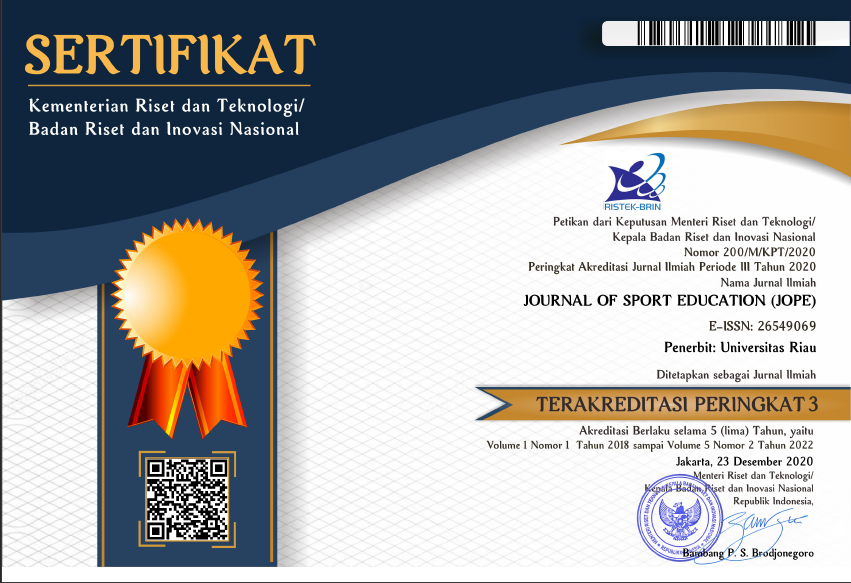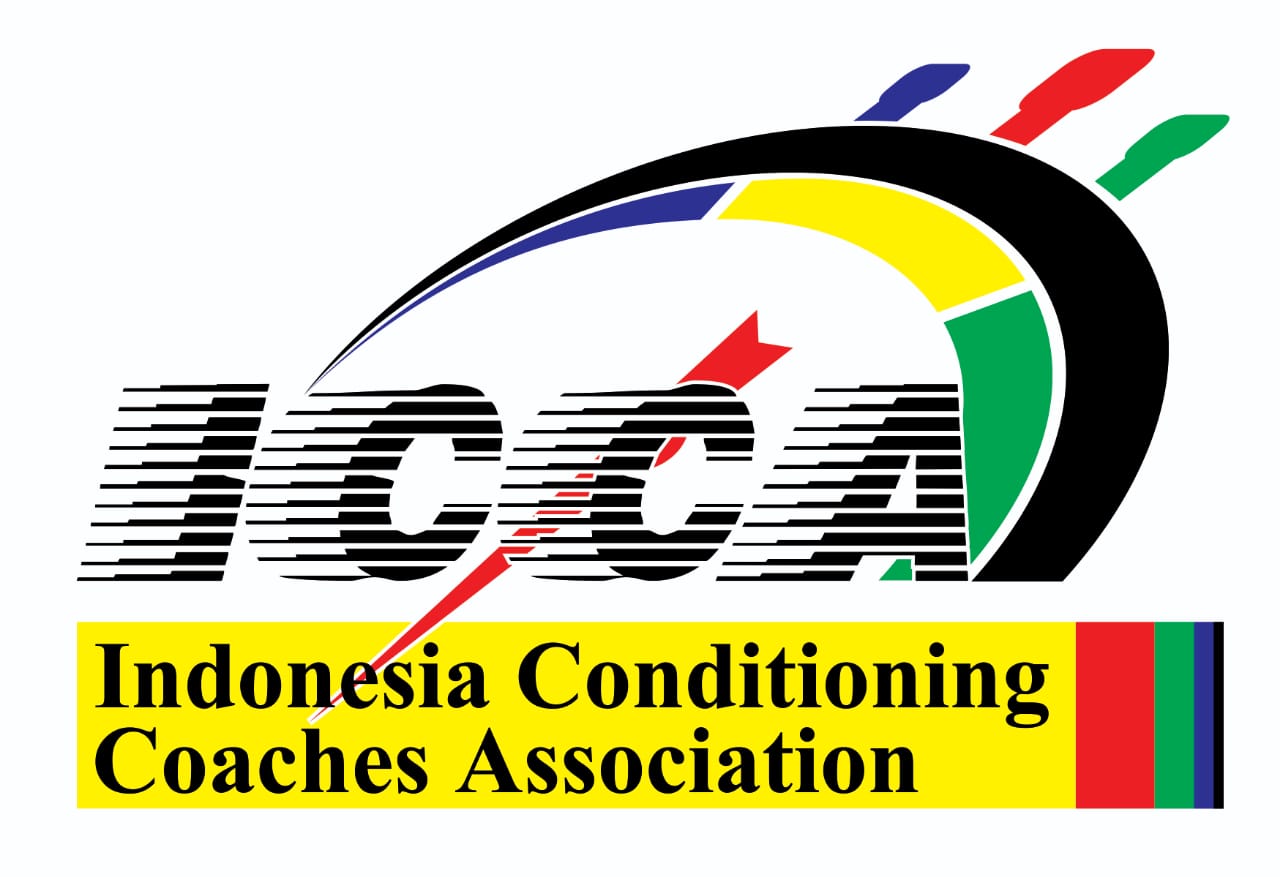The heart rate frequency of active individuals is lower than sedentary individuals during anaerobic physical activity (study on males 18-24 years old)
Abstract
(English)
Currently, in the field of sports and health it is believed that individuals who are active in physical activity or exercise regularly have a lower heart rate compared to sedentary individuals, both at rest and during physical activity. The heart rate reflects the intensity of a person's physical activity. This study aims to prove differences in heart rate frequency in active individuals and sedentary individuals when performing anaerobic physical activities. The subjects of this study were 16 active men and 16 sedentary men aged 18-24 years. This study used an experimental method with treatment in the form of anaerobic physical activity, namely push-ups, sit-ups and squats sequentially and monitoring the heart rate was recorded every 10 seconds. The results showed that the active group had a lower heart rate compared to the sedentary group when doing anaerobic physical activity. The conclusion of this study is that when doing the same anaerobic physical activity, for active individuals the increase in physical activity intensity that occurs is not as great as that experienced by sedentary individuals.
(Indonesian)
Saat ini, dalam bidang olahraga dan kesehatan diyakini bahwa individu yang aktif beraktivitas fisik atau rutin berolahraga memiliki frekuensi denyut jantung yang lebih rendah dibandingkan dengan individu sedenter, baik ketika istirahat maupun ketika beraktivitas fisik. Frekuensi denyut jantung mencerminkan intensitas aktivitas fisik yang dilakukan seseorang. Penelitian ini bertujuan untuk membuktikan perbedaan frekuensi denyut jantung pada individu aktif dan individu sedenter ketika melakukan aktivitas fisik anaerobik. Subyek penelitian ini adalah 16 orang laki-laki aktif dan 16 orang laki-laki sedenter berusia 18-24 tahun. Penelitian ini menggunakan metode eksperimen dengan perlakuan berupa aktivitas fisik anaerobik yaitu push-up, sit-up dan squat secara berurutan serta dilakukan pemantauan frekuensi denyut jantung yang dicatat setiap 10 detik. Hasil menunjukkan bahwa kelompok aktif memiliki frekuensi denyut jantung lebih rendah dibandingkan dengan kelompok sedenter ketika beraktivitas fisik anaerobik. Kesimpulan dari penelitian ini adalah bahwa ketika melakukan aktivitas fisik anaerobik yang sama, bagi individu aktif kenaikan intensitas aktivitas fisik yang terjadi tidak sebesar yang dialami oleh individu sedenter.
Copyright © The Author (s) 2023

Keywords
References
Amanuloh, J. H., Purba, R. H., & Setiakarnawijaya, Y. (2017). Hubungan Kadar Hemoglobin dan Denyut Nadi Istirahat Terhadap Kapasitas Aerobik Siswa SMKN 58 Jakarta Yang Mengikuti Ekstrakurikuler Futsal. 1–11.
Casey, D. P., & Joyner, M. J. (2012). Compensatory vasodilatation during hypoxic exercise: mechanisms responsible for matching oxygen supply to demand. The Journal of Physiology, 590(24), 6321–6326. https://doi.org/10.1113/JPHYSIOL.2012.242396
Chandel, N. S. (2021). Glycolysis. Cold Spring Harbor Perspectives in Biology, 13(5), a040535. https://doi.org/10.1101/CSHPERSPECT.A040535
Gilgen-Ammann, R., Schweizer, T., & Wyss, T. (2019). Accuracy of the multisensory wristwatch polar vantage’s estimation of energy expenditure in various activities: Instrument validation study. Journal of Medical Internet Research, 21(10), 1–9. https://doi.org/10.2196/14534
Gulati, M., Shaw, L. J., Thisted, R. A., Black, H. R., Noel Bairey Merz, C., & Arnsdorf, M. F. (2010). Heart rate response to exercise stress testing in asymptomatic women: The St. James women take heart project. Circulation, 122(2), 130–137. https://doi.org/10.1161/CIRCULATIONAHA.110.939249
Guyton, C. A., & Hall, E. J. (2016). Textbook of medical physiology (13th ed.). Elsevier Inc.
Hamdani, R., & Hasye, F. A. (2019). Efek Latihan Fisik Terhadap Remodeling Jantung. Jurnal Kesehatan Andalas, 8(2), 427. https://doi.org/10.25077/jka.v8i2.1021
Hermawan, L., Setyo, H., & Rahayu, S. (2012). Pengaruh Pemberian Asupan Cairan (Air) Terhadap Profil Denyut Jantung Pada Aktivitas Aerobik. JSSF (Journal of Sport Science and Fitness), 1(2), 14–20.
Karvonen, J., & Vuorimaa, T. (1988). Heart Rate and Exercise Intensity During Sports Activities: Practical Application. In Sports Medicine: An International Journal of Applied Medicine and Science in Sport and Exercise (Vol. 5, Issue 5, pp. 303–311). Springer. https://doi.org/10.2165/00007256-198805050-00002
Kasenda, I., Marunduh, S., & Wungouw, H. (2014). Perbandingan Denyut Nadi Antara Penduduk Yang Tinggal Di Dataran Tinggi Dan Dataran Rendah. Jurnal E-Biomedik, 2(1).
Matarneh, S. K., Scheffler, T. L., & Gerrar, D. E. (2023). The conversion of muscle to meat. In 9 (Ed.), Lawrie’s Meat Science. Woodhead Publishing Series in Food Science, Technology and Nutrition. https://doi.org/https://doi.org/10.1016/B978-0-323-85408-5.00010-8
McArdle, W. D., Katch, V. L., & Katch, F. I. (2009). Exercise Physiology: Nutrition, Energy, and Human Performance (7th ed.). Lippincott Williams & Wilkins.
Mendes de Almeida, M., da Silva, I., Ramires, V., Reichert, F., Martins, R., Ferreira, R., & Tomasi, E. (2018). Metabolic equivalent of task (METs) thresholds as an indicator of physical activity intensity. PLoS ONE, 13(7), 1–10. https://doi.org/10.1371/journal.pone.0200701
Mortazavi, B., Alsharufa, N., Lee, S. I., Lan, M., Sarrafzadeh, M., Chronley, M., & Roberts, C. K. (2013). MET calculations from on-body accelerometers for exergaming movements. 2013 IEEE International Conference on Body Sensor Networks, BSN 2013. https://doi.org/10.1109/BSN.2013.6575520
Müller, A. M., Wang, N. X., Yao, J., Tan, C. S., Low, I. C. C., Lim, N., Tan, J., Tan, A., & Müller-Riemenschneider, F. (2019). Heart rate measures from wrist-worn activity trackers in a laboratory and free-living setting: Validation study. Journal of Medical Internet Research, 21(10), 1–19. https://doi.org/10.2196/14120
Nath, S. (2006). A novel systems biology/engineering approach solves fundamental molecular mechanistic problems in bioenergetics and motility. Process Biochemistry, 41(10), 2218–2235. https://doi.org/10.1016/j.procbio.2006.07.003
Nelson, M. E., Rejeski, W. J., Blair, S. N., Duncan, P. W., Judge, J. O., King, A. C., Macera, C. A., & Castaneda-Sceppa, C. (2007). Physical activity and public health in older adults: Recommendation from the American College of Sports Medicine and the American Heart Association. Medicine and Science in Sports and Exercise, 39(8), 1435–1445. https://doi.org/10.1249/mss.0b013e3180616aa2
Norton, K., Norton, L., & Sadgrove, D. (2010). Position statement on physical activity and exercise intensity terminology. Journal of Science and Medicine in Sport, 13(5), 496–502. https://doi.org/10.1016/j.jsams.2009.09.008
Pangemanan, D. H. C., Engka, J. N. A., & Supit, S. (2012). Gambaran kekuatan otot dan fleksibilitas sendi ekstremitas atas dan ekstremitas bawah pada siswa/i SMKN 3 Manado.
Putra, K. P. (2020). Persentase Frekuensi Denyut Jantung Berdasarkan Rumus Karvonen. Satya Wacana University Press.
Putra, K. P., & Haridito, I. (2013). Pengaruh Program Pelatihan Fisik Militer Terhadap Peningkatan VO2Max Siswa Pendidikan Pertama Tamtama Tentara Nasional Indonesia Angkatan Laut. Jurnal Kesehatan Olahraga, 1(1). http://jurnalmahasiswa.unesa.ac.id/index.php/jurnal-kesehatan-olahraga/article/view/1922
Robergs, R. A., & Landwehr, R. (2002). THE SURPRISING HISTORY OF THE “HRmax=220-age” EQUATION. Journal of Exercise Physiology, 5(2), 1–10.
Sherwood, L. (2015). Fisiologi Manusia: Dari Sel ke Sistem (D. R. Herman Octavius Ong, Albertus Agung Mahode, Ed.; 8th ed.). EGC.
Tanaka, H., Monahan, K. D., & Seals, D. R. (2001). Age-predicted maximal heart rate revisited. Journal of the American College of Cardiology, 37(1), 153–156. https://doi.org/10.1016/S0735-1097(00)01054-8
DOI: http://dx.doi.org/10.31258/jope.5.2.113-123
Refbacks
- There are currently no refbacks.











